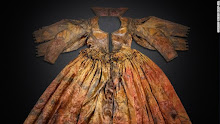The third post in my "Why Royal Weddings Matter" column for Confluence Daily, "Victoria's Choice," is reprinted below....to get you caught up on royal wedding history!
...................................
Victoria's Choice
If
you know one thing about wedding gown history, I would wager that it has something
to do with Queen Victoria beginning the bridal fashion of wearing white. (And
now, thanks to her, it has been a tradition of sorts for over 175 years.) But I
would also wager that most people don’t know the real reason the 20-year-old
monarch chose the color white for her
wedding gown, breaking the precedent set by earlier princess brides who
considered it their right to be “dressed in the usual cloths of silver or gold.”
Victoria even chose a crown of fanciful, yet wax orange blossoms instead of one of her dazzling diamond diadems.
Her
choices have since been regarded as representing simplicity, modesty and
purity—and indeed the young queen was sentimental
with an “uncluttered fashion preference,” according to costume historian Kay
Staniland. However, Victoria was deeply in love, and this became her guiding inspiration for her wedding attire. Therefore,
with much consideration—taking into account her duty, her position and her
subjects, carefully discussing her options with her Prime Minister, Lord
Melbourne—“the queen decided to make her marriage vows to her ‘precious Angel’
as his future wife rather than as the monarch,” wrote Edwina Ehrman, curator at
the Victoria and Albert Museum. So Victoria not only opted against wearing the ornate
silver and gold of royalty, but also her regal “crimson velvet robe of state”—first
worn at her coronation two years earlier—feeling “it would only emphasize her
seniority, and overshadow the role of her future husband,” Staniland added.
Victoria’s all-white bridal costume may
have been without the usual opulent royal accoutrements of silver and gold or
ermine-trimmed robes, but it “was actually exquisite and of great value,” explained
Maria McBride-Mellinger, author of The
Wedding Dress. Underscoring “patriotic spending,” the young queen commissioned
her country’s renowned textile artisans. The rich silk satin for the gown and its
18-foot court train (Victoria giving a subtle nod to her queenly status) was
woven in Spitalfields; and “two hundred women in a Devon village were employed
for eight months” making the beautiful, lyrically-patterned bobbin lace for her
gown’s embellishments as well as her short veil. The only color Victoria wore
was near her heart: a large, brilliant blue sapphire brooch which had been Prince
Albert’s wedding gift to her.
On the
day of the wedding, Victoria’s adoring subjects happily received their queen’s
choices, cheering her carriage on its way to the Chapel Royal at St. James’s
Palace. Dressed in these creamy shades of white and tufts of orange
blossom, I doubt that Victoria had a sense of the remarkably romantic lineage
she was about to inaugurate. (“Queen Victoria’s wedding and her gown inspired
an era and an industry,” wrote McBride-Mellinger.) Nor could she ever know that
her most queenly exemplar: “Keep your
relationship top priority,” would make fine advice for today’s busy wedding-planning
brides.
It
seems for this young bride (who just happened to be ruler of an empire), that it
came down to choosing the feelings of her future husband over her own ego. Victoria’s
heart-centered choice changed bridal history and, in turn, illuminated the supreme
sovereignty of a woman in love. ~
[Taken from The End of the Fairy-Tale Bride: For
Better or Worse, How Princess Diana Rescued the Great White Wedding,
available at Amazon.]























No comments:
Post a Comment